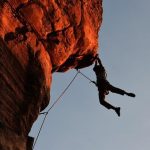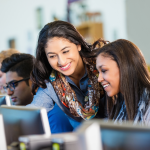Operation Outbreak: Simulating a pandemic while living it
Get important education news and analysis delivered straight to your inbox
On one recent morning, the advanced biology class at the Utah County Academy of Sciences faced a grim assignment. Seated at folding tables and speaking through face masks, students at this STEM-focused charter high school tallied Covid-19 infection and death rates from one winter week — comparing national and statewide data with the virus’s toll at their school.
Fortunately, the school’s disease numbers weren’t real. Led by Micah Ross, a biology teacher, the academy was piloting an app-based pandemic simulation, part of Operation Outbreak, a platform of lessons on infectious diseases and the public health response to their spread.
After learning about virus biology, immune response and past pandemics, more than 100 students and staff downloaded an app that tracked a virtual virus. The “virus”spread by Blue-tooth when participants were in close proximity for an extended time, and was slowed by digital masks and vaccines that students could get after taking quizzes based on the in-class lessons.
Co-created by an enterprising educator in Florida and some infectious disease researchers at the Broad Institute of MIT and Harvard, Operation Outbreak predates the pandemic, and its developers are keen to expand its use beyond the current crisis. For those who piloted the simulation in this extraordinary year, though, the meta-pandemic experience showed what data reveals and conceals about the global struggle with Covid-19.
“Remember,” Ross said to her class at one point, “all these numbers represent people.”
The partnership behind Operation Outbreak began with an international crisis and a star-struck 6-year-old.
From 2014 to 2016, Ebola ravaged several West African countries, killing thousands and spreading isolated cases to both Europe and the United States. As health authorities struggled to contain a virus spreading across borders, a middle school civics teacher in Florida named Todd Brown saw a teachable moment: Fighting threats like Ebola, he believed, was as much about government decisions, media coverage, international cooperation and public trust as it was about good science and heroic medical personnel.
“The student engagement was so strong. We were really amazed by that.”
Andrés Colubri, assistant professor of bioinformatics and integrative biology at UMass Medical School, who led the creation of the Operation Outbreak app
Brown crafted civics lessons about outbreak response for his eighth graders at Sarasota Military Academy Prep, a charter middle school. In the spring of 2016, Brown, with the help of a few other teachers, capped off the unit with a day of experiential learning, in which a couple hundred students roamed over the school grounds pretending to be government officials, epidemiologists, medical teams, media and members of the public as they confronted an infectious disease spreading through their ranks.
There was no app that first year. Instead, kids “infected” one another with stickers at designated times. “It was basically a scripted-out version of exponential spread,” explained Brown, who is leaving the school this summer to work full time with Operation Outbreak. The students’ goal was to contain the disease and use the evidence of its symptoms and spread to discover what it was (Ebola, MERS, bubonic plague, etc.) before it wiped out the whole population.
Related: How students learn from super-green schools that use zero energy
The next year, Brown’s simulated outbreak had a distinguished audience — Dr. Pardis Sabeti, a Harvard computational geneticist whose lab, affiliated with the Broad Institute, partners with scientists worldwide on infectious disease research and response. Brown had first contacted Sabeti a couple years earlier, after reading her Time magazine profile to his science-loving daughter, then 6 years old.
“We both thought she sounded amazing,” Brown recalled. “I asked my daughter if she would like me to reach out and get an autograph, and she was super excited.”
The autograph request (fulfilled) led to more conversations, a Skype visit by Sabeti with Brown’s class, and then the in-person visit with other members of her lab, who were impressed by Operation Outbreak and eager to lend their expertise.
At the time, one of the Sabeti Lab projects was developing models of disease spread that better accounted for the X factor of real human behavior. The researchers had hit on the idea of observing real people spreading a digital virus via Bluetooth around the same time that they observed Brown’s students scrambling to contain their sticker-based outbreak.
In the months that followed, one of Sabeti’s postdocs, Andrés Colubri, led the creation of Operation Outbreak’s mobile app, in which a virtual virus can be customized for how infectious it is, how virulent and whether it spreads asymptomatically. On-screen emojis differentiated the healthy, the sick and the deceased. Participants could earn digital “masks” by taking in-app quizzes on topics such as epidemiology, historical pandemics and the role of the World Health Organization. Sabeti’s team returned to the Florida middle school in 2018 to help pilot the app.
“The student engagement was so strong. We were really amazed by that,” said Colubri, now an assistant professor of bioinformatics and integrative biology at UMass Medical School.
“Remember, all these numbers represent people.”
Micah Ross, biology teacher, Utah County Academy of Sciences
Meanwhile, the simulations grew increasingly elaborate. For instance, when Brown randomly allotted participants differing amounts of virtual money to buy personal protective equipment or the food they needed, one enterprising student with extra cash bought up all the PPE and resold it at a premium.
At one point, Brown’s students playing government officials fed false information to the “media” to convince the “public” to quarantine. Then the media found out the truth, and the public no longer trusted or complied with any public health restrictions, accelerating contagion. Some students tried to fake their infection status by displaying screenshots of the happy, healthy emoji. And in one incident, a student playing the role of a police officer panicked while confronting a classmate who refused to reveal his health status and “shot” him with a Nerf gun.
Related: Learning to teach from naughty avatars
In late 2019, reality caught up with Operation Outbreak. That year’s pandemic simulation coincidentally used a SARS-like virus with asymptomatic spread. As the real virus became a global pandemic in early 2020, the parallels were unmistakable. Both the simulated and the real pandemics were characterized by panic, hoarding and medical teams overwhelmed by the carnage, while superspreaders and misinformation hobbled containment efforts. Much as Covid-19 disproportionately affected disadvantaged communities, the students randomly given fewer virtual dollars at the start of simulations got sick and died at higher rates than their “wealthier” classmates.
“The sociobehavioral parallels between our past simulations and the current pandemic are striking,” the Outbreak team wrote in a 2020 commentary for the journal “Cell.” “Simulations have repeatedly foreshadowed the political distrust and altercations that have increased alongside Covid-19 in the U.S.”
The value of pandemic education was suddenly evident. Plus, the data generated by simulations could serve as a guide for Covid-19 mitigation measures. In theory, for instance, a pandemic simulation could help school administrators show students and families the danger of superspreader events, or it could reveal the times and places where students had trouble staying socially distant.
Backed by the Gordon and Betty Moore Foundation, the Outbreak team began crafting standards-aligned lesson plans in two broad categories — science and governance — that could be tailored to different levels of complexity.
They also partnered with Fathom Information Design, a Boston firm that helps organizations make use of their data, to create a dashboard that displayed time-lapse renderings of the simulation — participants were shown as numbered dots, color-coded according to infection status, that moved in and out of contact with one another, spreading the virtual virus, getting sick, and then recovering, or not.
But, there was a major catch. While the real pandemic made Operation Outbreak extremely topical, it also made it far more challenging to implement. In the spring of 2020, most schools and colleges went remote and faced tremendous uncertainty about the next academic year.
“So many schools were going online, and then back in person, and then bouncing around,” Brown said. “We weren’t going to run a full-scale, totally immersive simulation like we ran in the past. It wouldn’t make sense to kind of force congregation in the middle of a pandemic.”
Instead, the team opted for what Brown called “a light-touch approach.” In addition to piloting the draft lesson plans, both K-12 and university partners could run a scaled-back simulation stretched over several days, with participants going about their routines, with no role-playing or scientific mysteries to solve, but with optional quiz-earned digital masks and other protections.
And remote schooling wasn’t the only challenge. Some schools welcomed the experiential learning, but worried about the mental health ramifications for students acting out a pretend disaster in the midst of a devastatingly real one.
“You had to be sensitive that some of the people in your community may have lost loved ones,” said Karen Bruker, a science teacher at The Cambridge School of Weston, a private high school outside Boston. In the simulation Bruker led last November with about 100 students, participants could get very sick, but nobody died. School staff also stressed that the simulated virus was similar to the one causing Covid-19, but it was not meant to be a precise digital imitation of the real pathogen.
“We weren’t going to run a full-scale, totally immersive simulation like we ran in the past. It wouldn’t make sense to kind of force congregation in the middle of a pandemic.”
Todd Brown, Florida middle school civics teacher who led a pilot virus simulation
During a Zoom interview, Bruker shared the time-lapse display of a two-day simulated outbreak at her school. Starting at 8 a.m. on Day One, a few red dots of seeded “infections” moved through a constantly shifting web of gray dots, turning several more red before Bruker paused the playback at 10:30 a.m.
“We already had eight secondary infections at this point,” said Bruker, who had promptly emailed an update to students about the simulated surge, reminding them of social distancing and that a quiz for digital masks would soon be available. Participants, taking the hint, used the quiz to earn their masks, and secondary infections plummeted.
Related: A 17-year-old wants to spice up science classes and, eventually, democratize education
As usual, the simulated outbreaks revealed insights about human behavior along with lessons on viral contagion. At Brigham Young University, for instance, about 400 students in a nine-day pandemic simulation were offered a digital vaccine, obtained by scanning a QR code available in the university’s Life Sciences Building. The vaccines were promoted via daily emails, but only 15 percent of the students bothered to scan the code.
The simulation’s lead organizer, Curtis Hoffmann, a senior microbiology major, noted that most participants in a pre-simulation survey said they had no hesitancy about getting the actual vaccine. He blamed the low digital follow-through partly on the inconvenience of its being offered at just one location during a busy week that coincided with midterms.
“One of the takeaways we shared to the university’s Covid-19 committee was to suggest they offer the vaccine at multiple sites on campus,” said Hoffmann.
The real pandemic didn’t just make the simulation hyper-relevant, it also prompted discussions about the purpose and limitations of computer models for predicting disease. Back at the Utah County Academy of Sciences, for instance, Ross’s class discussed why 14 percent of their simulation participants had died, far outpacing the state and national death rates.
They noted how tenuous results are in a simulated pandemic spreading among just 111 people. They mentioned technical glitches with the app on some of their Chromebooks that disrupted some of the quizzes needed to earn a digital mask, and the fact that people who had been digitally “infected” in the simulation carpooled and came to school as they normally would, while in real life, truly ill students would stay home once they knew they were sick.
Ross and her students talked about revisiting the simulation next year, involving more students, and they pondered how results might differ without a real pandemic lurking in the background.
“If the pandemic isn’t currently raging, how would it change how you interact with your friends at school and outside school?” she asked.
Near the end of class, Ross asked her students what changes they would want in future pandemic simulations, and their answers revealed the real pandemic’s lessons. One suggested that the virus could mutate midsimulation. Another ventured that participants should be randomly sorted into different groups based on population vulnerabilities and preexisting medical conditions.
“Our data doesn’t personalize risk and variability,” he said. “You just see a bunch of dots.”
This story about a pandemic simulation was produced by The Hechinger Report, a nonprofit, independent news organization focused on inequality and innovation in education. Sign up for our higher education newsletter.
Published at Sun, 23 May 2021 09:01:00 +0000
Article source: https://hechingerreport.org/operation-outbreak-simulating-a-pandemic-while-living-it/



